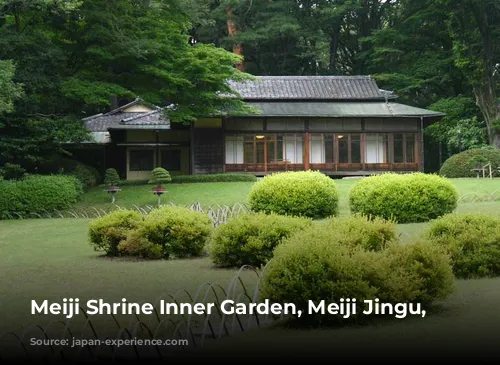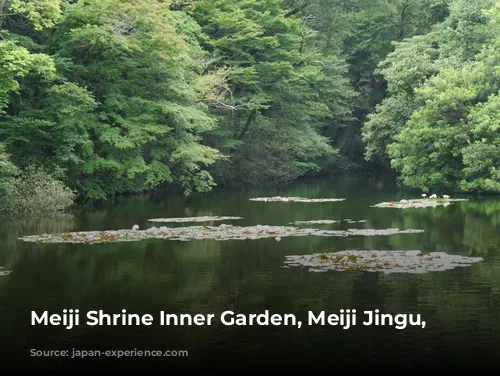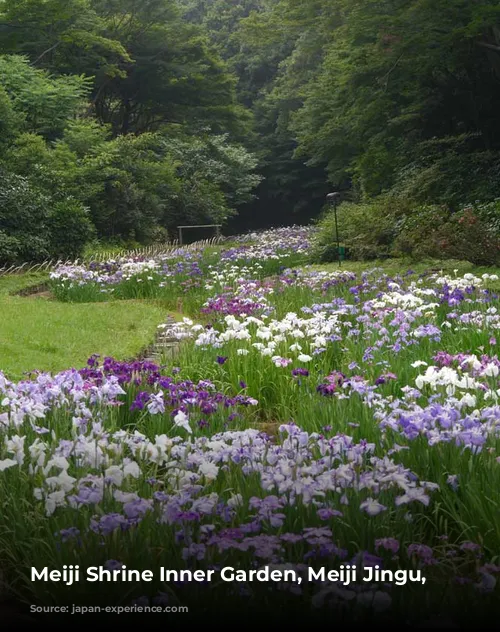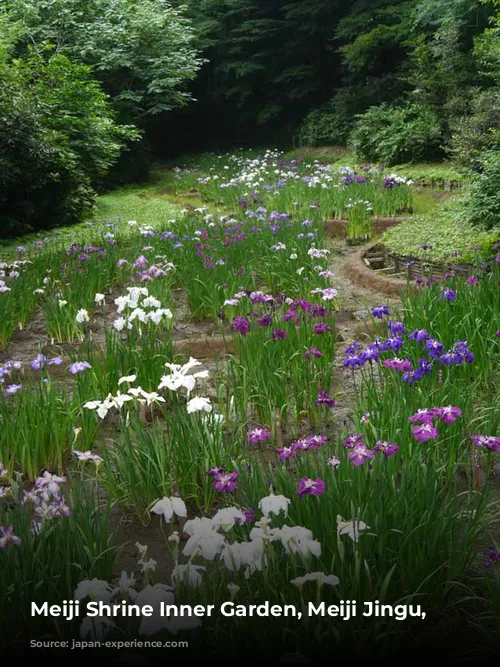Step into a world of history, culture, and nature as you explore the Meiji Jingu Inner Garden, a hidden gem nestled within the bustling city of Tokyo. This tranquil oasis boasts a rich history dating back centuries, offering a captivating glimpse into Japan’s transformation from a feudal society to a modern nation.

A Garden with a Story to Tell
The Meiji Jingu Inner Garden predates the famous Meiji Shrine itself, its roots reaching back to the early Edo Period (1603-1867). Built by Lord Kato of Kumamoto, a prominent military commander renowned for his role in constructing the majestic Kumamoto Castle in 1610, the garden’s history is as compelling as the stories it holds.
During the Meiji Period, the garden’s significance soared as it became part of the Imperial estate. Emperor Meiji, a pivotal figure in Japan’s modernization, left his mark by adding various features to the garden, including the elegant Kakuun-tei teahouse, a testament to his profound respect for his beloved Empress Shoken.
Today, the Inner Garden stands as a living testament to Japan’s rich history, beautifully blending tradition and progress, reflecting the very essence of the Meiji era.

A Serene Retreat with Hidden Treasures
The Meiji Jingu Inner Garden beckons visitors with its captivating charm, offering a variety of captivating features that allure the senses throughout the year.
A Floral Paradise
The Iris Garden, the crown jewel of the Inner Garden, is a breathtaking spectacle that transports visitors to a floral paradise. Imagine a stunning tapestry of over 1,500 iris plants, representing 150 different species, meticulously arranged in a breathtaking display. This floral marvel was a personal creation of Emperor Meiji himself, transformed from a former samurai training ground into a vibrant haven for Empress Shoken.
Tranquility by the Pond
The Nan-chi Pond, a sprawling expanse of water covering an impressive 8,300 square meters, offers a serene retreat. Fed by pure spring water, the pond is home to graceful carp, some believed to be descendants of those released by Emperor Meiji himself over a century ago.
A Historical Well
Nestled within the garden lies Kiyomasa’s Well, a testament to the Edo Period, named after the military commander who dug it around 400 years ago. This well stands as one of the most famous from that era, with its water maintaining a constant temperature of 15 degrees Celsius (59 degrees Fahrenheit) year-round. This unique feature provides irrigation for the Iris Garden and nourishes the Nan-chi Pond.
Kakuun-tei Teahouse: A Sanctuary for Empress Shoken
Commissioned by Emperor Meiji, the Kakuun-tei Teahouse graces the landscape overlooking the serene Nan-chi Pond. This elegant structure served as a rest house for Empress Shoken, offering stunning views of the surrounding garden.
Azaleas and Maples: A Kaleidoscope of Colors
The Azalea Garden, a complement to the iris display, is a vibrant tapestry of azalea trees, some reaching over a century old. Surrounding the garden are majestic Japanese maple trees, their vibrant foliage providing a breathtaking spectacle, especially during autumn.
A Journey Through the Seasons
The Meiji Jingu Inner Garden is a place where nature’s beauty unfolds throughout the year, each season offering a unique experience.
Spring: A Burst of Color
Spring awakens the garden with a vibrant symphony of blooming flowers. Trout lilies (Katakuri) emerge in mid-March, followed by Japanese globeflowers (Yamabuki) and wisteria (Fuji) in April. The azalea garden reaches its peak in late April, with vibrant colors bursting from trees over a century old.
Summer: A Symphony of Irises
Summer marks the peak of the Iris Garden with its dazzling display of 1,500 iris plants in full bloom from late May to late June. This spectacle draws visitors from across the globe to witness the garden’s floral splendor. Water lilies (Suiren) also grace the pond from June to September.
Autumn: A Tapestry of Colors
As the air cools, the garden transforms into a breathtaking tapestry of autumn foliage. The Japanese maples stand out in late November to mid-December, painting the landscape with warm hues.
Winter: A Serene Escape
Winter, despite its seemingly dormant appearance, offers a unique charm. From November to March, visitors may spot mandarin ducks in the pond, adding a touch of color to the winter landscape. The garden is also a haven for kingfishers year-round, providing birdwatching opportunities throughout the year.

Practical Tips for Your Visit
To ensure a fulfilling visit to the Meiji Jingu Inner Garden, consider the following practical information:
- Admission and Hours: The Inner Garden requires a separate entrance fee of 500 yen. It’s open from 9:00 am to 4:30 pm daily, with last admission 30 minutes before closing. Hours may be extended during the peak iris blooming season in mid-June.
- Access: The garden is easily accessible from several stations:
- Harajuku Station on the JR Yamanote Line (Omotesando Exit)
- Meiji-jingu-mae Station on the Chiyoda Subway Line
- Kita-sando Station on the Fukutoshin Line of the Tokyo metro
- Best Time to Visit: To avoid crowds, consider visiting early in the morning or on weekdays. For a truly tranquil experience, aim to arrive when the gates open at 9:00 am.
- Facilities: While the garden itself doesn’t have many amenities, the surrounding Meiji Shrine complex offers restrooms and vending machines. Bring your own water, especially during summer months.
- Photography: Photography is allowed in most areas of the garden, but be respectful of other visitors and any restricted areas.

Exploring Beyond the Garden
The Meiji Jingu Inner Garden is an integral part of the larger Meiji Jingu complex, one of Tokyo’s most significant Shinto shrines. After exploring the Inner Garden, visitors can easily access the main shrine buildings, dedicated to the deified spirits of Emperor Meiji and Empress Shoken.
The shrine and garden are adjacent to the expansive Yoyogi Park, offering additional green space for relaxation or recreation. The contrast between the serene atmosphere of the shrine complex and the vibrant energy of nearby Harajuku is striking, highlighting Tokyo’s unique blend of tradition and modernity.
For those interested in exploring further, the fashionable districts of Omotesando Avenue and Aoyama are within walking distance. The bustling areas of Shibuya and Shinjuku are just a short train ride away on the Yamanote Line, making the Inner Garden a perfect starting point for exploring Tokyo’s diverse neighborhoods.
A Living Legacy
The Meiji Jingu Inner Garden is much more than just a beautiful space; it’s a living, breathing piece of Japanese heritage. This tranquil oasis invites you to step back in time, immerse yourself in nature’s beauty, and gain a deeper appreciation for the delicate balance between progress and tradition that defines modern Japan. Whether you’re a first-time visitor to Tokyo or a long-time resident, this hidden gem offers a refreshing escape and a chance to connect with the heart of Japanese culture and nature.

